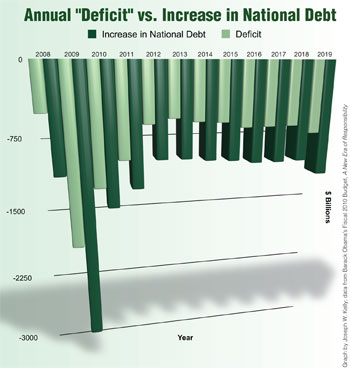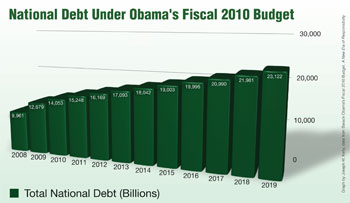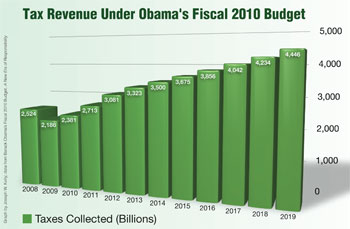
The Post quoted officials of the Department of Veterans Affairs as saying they would hire some 17,000 new workers alone. A Heritage Foundation study estimates that nearly a quarter million new government workers will be needed to spend out the budget.
But despite the prospects of full employment among government workers in the Washington, D.C., beltway, the rest of the country is in a bit rougher shape. The GDP shrunk in the last quarter of 2008 at a 6.2 percent annualized rate, the worst in more than a generation. “Every major component of the economy shrank,” the New York Times for February 28 noted, “except government spending.” President Obama’s $3.55 trillion budget proposal would at least protect that final growing node of the national “economy.”
The Basics: Tax, “Invest,” and Borrow
President Obama’s February 24 address to a joint session of Congress two days before releasing his budget estimates reveals that the federal government won’t be “spending” money anymore. From now on, all taxpayer funds will be “invested” rather than “spent.” President Obama used a form of the word “invest” a dozen times to refer to future government spending in that address, but limited use of the word “spend” to past spending in all but one occasion, even adding that: “I have told each member of my Cabinet as well as mayors and governors across the country that they will be held accountable by me and the American people for every dollar they spend.” The deceptive sales job had already begun before the budget was released.
“Spending” may be out, but big-government spending programs aren’t. You won’t hear Barack Obama utter Bill Clinton’s claim that “the era of big government is over.” Obama hopes to double taxes from the current $2.1 trillion to $4.2 trillion by 2018. And even those massive tax increases won’t cut the budget deficit much, because spending will keep pace with the tax increases. President Barack Obama may have called his fiscal 2010 budget proposal A New Era of Responsibility, but the budget generates a new era of irresponsibility when it comes to adding to the national debt and spending policies. He proposes to double the national debt by 2019 to more than $23 trillion.
Nearly half of the $3.9 trillion of spending in the current fiscal 2009 budget will now be borrowed, thanks in part to the $787 billion American Recovery and Reinvestment Act, every penny of which was deficit spending. The bill contained a provision that increased the statutory limit on the national debt by the total amount in the bill. President Obama might as well have signed that law in a pen with red ink.
The budget plans for another bailout, adding a $250 billion “placeholder” provision toward an additional $750 billion in bailouts, based on the assumption that the government would be able to recoup $500 billion for the toxic assets it buys.
Debt and Deficits
President Obama proclaimed a more “honest” and “open” budget process, and — give him some credit — he did move the cost of the Iraq and Afghan wars back onto the budget from the Bush administration. But he still has a long way to go before he can say it’s an “honest” budget, as is made clear by his highly publicized pledge to cut the deficit “in half, ” to $533 billion, by the end of his term. That pledge is reflected in his new budget proposal. However, this pledge is fraught with three types of numerical chicanery.
 First, before the forecast annual deficit drops to $533 billion in the Obama budget, it first shoots up to $1.75 trillion for the current fiscal year, which ends this September 30. The baseline that is being used in order to portray a $533 billion deficit as a 50 percent cut is not the $453 billion deficit for the previous fiscal year. Obviously, if last year’s record-setting deficit were being used as the baseline, then Obama’s projected $533 billion deficit for the end of his first term would mean an 18-percent increase, not a 50-percent decrease. The baseline that is instead being used is the $1 trillion-plus deficit that was being projected for the current fiscal year when Obama became president. Of course, President Obama has since championed spending programs that have ballooned that projection to $1.75 trillion. Not only that, but he supported big spending programs as a U.S. senator that contributed to the deficit he inherited as president, including last year’s $700 billion TARP legislation.
First, before the forecast annual deficit drops to $533 billion in the Obama budget, it first shoots up to $1.75 trillion for the current fiscal year, which ends this September 30. The baseline that is being used in order to portray a $533 billion deficit as a 50 percent cut is not the $453 billion deficit for the previous fiscal year. Obviously, if last year’s record-setting deficit were being used as the baseline, then Obama’s projected $533 billion deficit for the end of his first term would mean an 18-percent increase, not a 50-percent decrease. The baseline that is instead being used is the $1 trillion-plus deficit that was being projected for the current fiscal year when Obama became president. Of course, President Obama has since championed spending programs that have ballooned that projection to $1.75 trillion. Not only that, but he supported big spending programs as a U.S. senator that contributed to the deficit he inherited as president, including last year’s $700 billion TARP legislation.
Second, Obama assumes an unrealistically rosy economic picture through 2013 in order to arrive at his deficit of “only” $533 billion. His deficit figures assume only a 1.2 percent decrease in GDP for fiscal 2009, even though we’ve already seen more than that amount of a decrease in the first quarter of this fiscal year alone (Oct.-Dec. 2008). His economic estimates are the most rosy of any prediction being made today. Even the Congressional Budget Office admits fiscal 2009 will see a -2.2 percent change in GDP. Obama’s forecasts get rosier in future years, predicting a robust 3.2 percent growth for fiscal 2010 and 4 percent or greater growth in each of the years from 2011-13. And it just happens to suit Obama’s interests to predict robust growth. More growth means more tax revenue and lower spending levels for unemployment benefits and welfare programs. So the more growth he can claim, the lower he can predict the deficit will be.
Third, even if Obama’s tax-and-spend policies result in a Pollyannaish economic recovery that brings the predicted economic boom, the first chart demonstrates his annual deficit figures are not true deficit figures. They fall far short of the corresponding increases in the national debt. In fact, according to the president’s own budget, the national debt will grow by about a trillion dollars or more each year through fiscal year 2019, the last year for which figures are shown.
How do you cut the annual deficit to “only” $533 billion while still increasing the national debt by about $1 trillion or more every year? It’s being done the same way past administrations have done it: concealing the enormity of the deficits through the “off-budget” theft of “trust funds.” Prime among these are the Social Security trust fund, Medicaid, and federal employee retirement trust funds. Those funds are being filled with “IOUs” that are not factored into the deficit figures. Each of these funds will come due in the coming decades, and taxpayers will pay the price of the liability for them straight out of their tax bills. “Trust fund” theft accounts for $250-400 billion per year in concealed additional debt.
President Obama also conceals about $100 billion per year in debt from TARP and “direct loan” accounts for various financial bailouts, all of which remain “off budget.”
Education: More Federal Dollars
 President Obama told a joint session of Congress on February 24 that he plans to “invest” (“spend” if you live outside of Washington) more taxpayer dollars in three key areas: “Now is the time to act boldly and wisely — to not only revive this economy, but to build a new foundation for lasting prosperity. Now is the time to jump-start job creation, re-start lending, and invest in areas like energy, health care, and education that will grow our economy.”
President Obama told a joint session of Congress on February 24 that he plans to “invest” (“spend” if you live outside of Washington) more taxpayer dollars in three key areas: “Now is the time to act boldly and wisely — to not only revive this economy, but to build a new foundation for lasting prosperity. Now is the time to jump-start job creation, re-start lending, and invest in areas like energy, health care, and education that will grow our economy.”
If more education spending were the key to a booming economy, we’d already be in the midst of the largest economic boom ever. During the Bush administration, total education spending increased an unprecedented 80 percent, from $35.5 billion to $63.8 billion. Clearly, throwing money at education did not spark the economy. But President Obama would do more of the same, although he has yet to make total figures available. “Discretionary” education spending — a little more than half the current total that also includes “mandatory” education spending – would increase from $41.4 billion in fiscal 2009 to $64.5 billion by 2013, an increase of nearly 56 percent over just four years.
President Obama has proposed a dramatic increase in the federal role in education despite admitting in his February 24 address to a joint session of Congress: “In the end, there is no program or policy that can substitute for a mother or father who will attend those parent/teacher conferences, or help with homework after dinner, or turn off the TV, put away the video games, and read to their child. I speak to you not just as a President, but as a father when I say that responsibility for our children’s education must begin at home.”
His lips tell us that education begins in the home, but his budget tells us that it begins in Washington.
Healthcare and Energy
 President Obama’s other major “investments” in our economy are healthcare, infrastructure, and energy. In healthcare, the big-ticket item is a healthcare “reserve fund of more than $630 billion over 10 years to finance fundamental reform of our health care system that will bring down costs and expand coverage.” And that claim brings up two questions: if $630 billion is just the “down payment,” what’s the total bill going to be? And, if $630 billion is just the down payment, how exactly is that going to bring the costs down?
President Obama’s other major “investments” in our economy are healthcare, infrastructure, and energy. In healthcare, the big-ticket item is a healthcare “reserve fund of more than $630 billion over 10 years to finance fundamental reform of our health care system that will bring down costs and expand coverage.” And that claim brings up two questions: if $630 billion is just the “down payment,” what’s the total bill going to be? And, if $630 billion is just the down payment, how exactly is that going to bring the costs down?
Government is known for doing lots of things, but bringing costs down is not one of them. This is the same federal government that managed to turn a proposed $2 billion infrastructure “Big Dig” project in Boston into an unsafe $15 billion (and counting) highway project. The tunnel project depressed Boston’s central artery, went more than 600 percent over budget, leaks more than a million gallons of water per day, and has already claimed the life of one woman who was crushed by a falling concrete ceiling tile. Barack Obama claims projects like this can spur economic growth, and that putting the same body that was responsible for the cost controls and safety controls of the Big Dig in charge of your healthcare is a good way to cut costs.
Obama’s energy proposals are a shopping list of feel-good projects, based upon the assumption that all innovation stems from government (rather than private, market-based) initiatives. So Obama included $1.6 billion more for general science support, loan guarantees for reducing greenhouse emissions (with an omission on the costs of this program), $3.4 billion for low-carbon coal projects, and $11 billion for “smart grid” electricity programs. The energy budget includes $39 billion from the American Recovery and Reinvestment Act of 2009 bailout law.
Where’s the “Peace Dividend”?
Candidate Barack Obama pledged to get the United States out of Iraq, one of the two costly wars of occupation in which the United States is currently engaged. However, President Obama is increasing the total military budget over even the “surge” levels of the current year. His budget proposal states:
The 2010 Budget for the Department of Defense (DOD) requests $533.7 billion, or an increase of four percent from the 2009 enacted level of $513.3 billion (excluding funding from the American Recovery and Reinvestment Act of 2009). This funding increase allows DOD to address its highest priorities, such as the President’s commitment to meet the military’s goal to increase the size of the Army and Marine Corps, to continue to improve the medical treatment of wounded servicemembers, and to reform the acquisition process.
So where’s the “peace dividend”? Barack Obama’s budget seems to indicate that he will be increasing U.S. military involvement abroad, rather than the decrease he promised as a candidate. And if we’re reducing our deployments abroad, why would we need more people in the armed services? Clearly, a draw-down of our commitments abroad is not where the United States is headed.
“We can’t posture and bicker and resort to the same failed ideas that got us into this mess in the first place,” President Barack Obama told a manufactured “town hall”-style crowd in Elkhart, Indiana, on February 9. But Obama’s budget and economic policy is more of the same old Bush administration policy: more foreign military engagements, more bailouts, more spending, and more debt.
“You can’t outbid a profligate,” former congressman William “Bourke” Cockran once quipped of his big-spending colleagues. President Barack Obama seems determined to prove Cockran’s statement true. President George W. Bush hijacked the conservative movement and the Republican Party with his “compassionate conservatism” and tried to outbid liberalism. But while he put the nation on the fast lane to economic ruin, all he proved was that you can’t outbid a profligate.
Thomas R. Eddlem, a freelance writer, served as the John Birch Society’s director of research from 1991-2000.
Photo: AP Images



